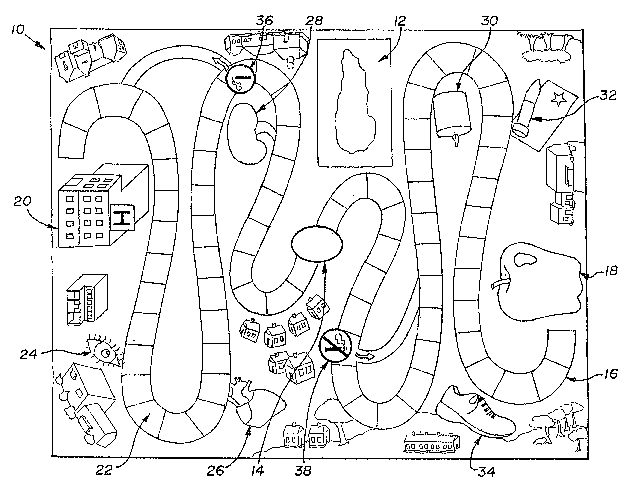Some of the information on this Web page has been provided by external sources. The Government of Canada is not responsible for the accuracy, reliability or currency of the information supplied by external sources. Users wishing to rely upon this information should consult directly with the source of the information. Content provided by external sources is not subject to official languages, privacy and accessibility requirements.
Any discrepancies in the text and image of the Claims and Abstract are due to differing posting times. Text of the Claims and Abstract are posted:
| (12) Patent Application: | (11) CA 2548579 |
|---|---|
| (54) English Title: | HEALTH EDUCATION BOARD GAME |
| (54) French Title: | JEU DE TABLE D'EDUCATION SANITAIRE |
| Status: | Deemed Abandoned and Beyond the Period of Reinstatement - Pending Response to Notice of Disregarded Communication |
| (51) International Patent Classification (IPC): |
|
|---|---|
| (72) Inventors : |
|
| (73) Owners : |
|
| (71) Applicants : |
|
| (74) Agent: | MARKS & CLERK |
| (74) Associate agent: | |
| (45) Issued: | |
| (86) PCT Filing Date: | 2004-12-09 |
| (87) Open to Public Inspection: | 2005-06-30 |
| Availability of licence: | N/A |
| Dedicated to the Public: | N/A |
| (25) Language of filing: | English |
| Patent Cooperation Treaty (PCT): | Yes |
|---|---|
| (86) PCT Filing Number: | PCT/US2004/041564 |
| (87) International Publication Number: | US2004041564 |
| (85) National Entry: | 2006-06-08 |
| (30) Application Priority Data: | ||||||
|---|---|---|---|---|---|---|
|
A board game for facilitating health education by involving players in
scenarios leading to either ~health~ or ~illness.~ Players move game pieces
along a path (16) between ~health~ (18) and ~illness~ (20) by drawing game
cards depicting various health-related content specific to the theme of the
game, deciding if the scenario relates to health or illness, and then moving
the game piece in the appropriate direction to a corresponding color-coded
space.
L'invention concerne un jeu de table destiné à faciliter l'éducation sanitaire par implication de joueurs dans des scénarios concernant soit la "santé" soit la "maladie". Les joueurs déplacent des pions de jeu le long d'un trajet (16) entre "santé" (18) et "maladie" (20) par tirage de cartes de jeu représentant divers contenus relatifs à la santé spécifiques au thème du jeu, définissant si le scénario concerne la santé ou la maladie, le jeu consistant à déplacer la pièce de jeu dans le sens approprié vers un espace codé par une couleur correspondante.
Note: Claims are shown in the official language in which they were submitted.
Note: Descriptions are shown in the official language in which they were submitted.

2024-08-01:As part of the Next Generation Patents (NGP) transition, the Canadian Patents Database (CPD) now contains a more detailed Event History, which replicates the Event Log of our new back-office solution.
Please note that "Inactive:" events refers to events no longer in use in our new back-office solution.
For a clearer understanding of the status of the application/patent presented on this page, the site Disclaimer , as well as the definitions for Patent , Event History , Maintenance Fee and Payment History should be consulted.
| Description | Date |
|---|---|
| Application Not Reinstated by Deadline | 2010-12-09 |
| Time Limit for Reversal Expired | 2010-12-09 |
| Inactive: Abandon-RFE+Late fee unpaid-Correspondence sent | 2009-12-09 |
| Deemed Abandoned - Failure to Respond to Maintenance Fee Notice | 2009-12-09 |
| Inactive: Office letter | 2008-12-16 |
| Extension of Time to Top-up Small Entity Fees Requirements Determined Compliant | 2007-12-05 |
| Inactive: Cover page published | 2006-08-23 |
| Inactive: Inventor deleted | 2006-08-16 |
| Inactive: Notice - National entry - No RFE | 2006-08-16 |
| Application Received - PCT | 2006-07-04 |
| Small Entity Declaration Determined Compliant | 2006-06-08 |
| National Entry Requirements Determined Compliant | 2006-06-08 |
| National Entry Requirements Determined Compliant | 2006-06-08 |
| Application Published (Open to Public Inspection) | 2005-06-30 |
| Abandonment Date | Reason | Reinstatement Date |
|---|---|---|
| 2009-12-09 |
The last payment was received on 2008-12-02
Note : If the full payment has not been received on or before the date indicated, a further fee may be required which may be one of the following
Patent fees are adjusted on the 1st of January every year. The amounts above are the current amounts if received by December 31 of the current year.
Please refer to the CIPO
Patent Fees
web page to see all current fee amounts.
| Fee Type | Anniversary Year | Due Date | Paid Date |
|---|---|---|---|
| Basic national fee - small | 2006-06-08 | ||
| MF (application, 2nd anniv.) - small | 02 | 2006-12-11 | 2006-06-08 |
| MF (application, 3rd anniv.) - standard | 03 | 2007-12-10 | 2007-11-27 |
| MF (application, 4th anniv.) - small | 04 | 2008-12-09 | 2008-12-02 |
Note: Records showing the ownership history in alphabetical order.
| Current Owners on Record |
|---|
| SHEILA HERMAN |
| Past Owners on Record |
|---|
| None |